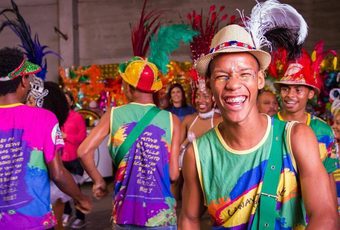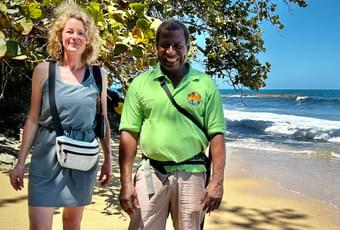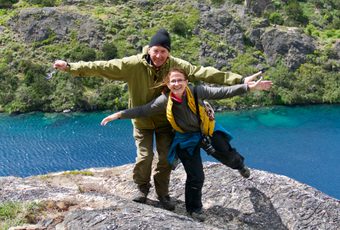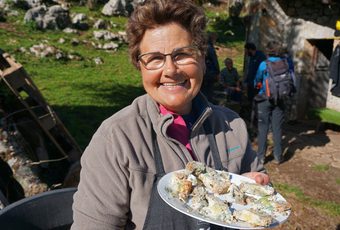Six sensationally scenic walks for your Azores holiday
Hiking is a great way to experience the Azores.
This is because there is a wonderful network of official walking trails across all nine islands. On each island, you have a choice of easy, moderate and more challenging routes.
Some are circular, others are linear, some take you from the forests of the highlands down to the sea, whereas others thread their way along beautifully quiet coastlines. Some give you more active ways to explore some of the more well-known sights, and so are a great way to find peaceful havens away from the hotspots and get views that others don't.
Many also have natural saltwater swimming spots or nice places to have a coffee with a view along the way. So it's not all about the walking!
So... What I have done here is pick out six trails across four different islands that I think best represent this broad mix. They also represent the slow, quiet rhythm of exploring, which I think always works best in the Azores. So let's jump right in!
1. Sete Cidades, São Miguel
We have to start on São Miguel. This is the biggest island and the one your travels will likely begin on. And on São Miguel, we have to start with the Sete Cidades - the huge volcanic crater complex in the northwest of the island.
This is a popular spot. The most photographed place in the whole of the Azores. Therefore, when you get to the viewpoints at the top, it's liable to be busy. Most people drive from viewpoint to viewpoint and then disappear off somewhere else.
The truly great thing about the walks at Sete Cidades is that you can be right in the buzz and excitement of your fellow travellers, all drinking in this incredible view over the crater lakes, and then you simply start walking and within five minutes you are in a woodland.
You can hear the birds singing and the wind rustling. You come out of that and you have the crater lakes on your right, the ocean on the left, hydrangeas on both sides.
What you are doing is tracing the course of the rim for most of the walk, then you drop down into the village in the crater itself, right by the lakeside. You might pass a dozen or so people as you walk along a wide and easy path.
It's nice to have a bit of a sit-down when you get to the bottom. There's a real quiet beauty down here that makes for a nice contrast with the scale and grandeur of the views at the top.
You then just head into the village and there's a choice of cafes and restaurants, one of which is arguably the quirkiest and most fun on the whole island.
When you're ready, you get a taxi back up to your car and off you go, maybe to the beach or the thermal sea pools if it's low tide - they are a real experience!
On this side of the crater, the Sete Cidades walk is a touch under 8km and is officially rated as easy. It is very easy going until the last stretch, which descends steeply on a quiet concrete road. So if you ever suffer from issues with your knees, you'll want to bring along hiking poles to help with that part.
Or find one like this along the trail...

2. Gorreana tea fields, São Miguel
The second hike is also on São Miguel and is even shorter. It's only 3.4km, so it should take you an hour or so.
The setting is the Gorreana tea plantation on the north coast of the island. There are two tea plantations here, the only two of their kind in Europe in fact.
Gorreana is the famous one, Porto Formoso is much smaller and much less visited, but it's actually the better of the two places to sit outside with a cuppa with the ocean, the tea fields and a bank of hydrangeas below.
The circular route begins and ends at the Gorreana tea factory. It takes you out into the heart of the tea fields, far away from the busyness of the factory. So you get a real sense of that quiet ambience you'd expect of a place like this.
Of course, what makes it really special is when that silence is broken by a team of harvesters out in the field with their slightly cumbersome strimmers. It's what I really enjoy about these tea farms - all the activity, inside the factory or out in the fields, just happens whether the visitors are there or not.
Nothing is for show. It's just locals doing their jobs. We can't arrange it for you, it can't be booked in. You just have to pop up in the right place at the right time - but it's much more fun that way, right?
This walk is short and mainly on wide and clear tracks. It gets a little tricky up in the higher parts of the farm, but only for a minute or two. Just like at Sete Cidades, the idea is that you don't have to just turn up at the same bit as everyone else, have a bit of a nose around and then leave with a few photos.
Going for a walk, staying a little longer, letting things come to you - that's the way to do it. It makes your memories much more vivid and lasting, and I think it gives these famous guidebook places much more personal meaning.


3. Criança Velha vineyards, Pico
Walk number three takes us to Pico, one of the three 'Triangle Islands' in the centre of the archipelago, and my personal favourite of all the islands.
These islands - Pico, Faial and São Jorge - have a smaller, personal and slow-paced feel. They are particularly suited for walking in this regard.
You might have read about hikes going up to the summit of Pico, Portugal's highest mountain. It's obviously incredible, but that's what I'd consider a specialist hike; it really isn't for everyone and so I see it as very much a different experience.
Pico's best walk, for me at least, is the flat 8km route Criança Velha trail and very much is for everyone. It runs around and through the wine landscapes on the slopes of Pico volcano.

Why is it special? For one, you're walking through a UNESCO World Heritage landscape. The lower slopes of Pico volcano are covered in these lava-rock vineyards, where bush vines are enclosed by thousands of kilometres of black rock walls for as far as the eye can see, a sea of green and black punctuated by a bright red windmill. Pico volcano looms large over it all.
The other thing is that you have three natural sea pools that you can swim in on the way - particularly great when the sun is out. These pools are a real signature of the Azores. On Pico, in particular, they are dotted the whole way along the coast. There are not many beaches on the island, but there are a LOT of sea pools. So you often find this is where locals come to hang out, but never in any great numbers.
It works really well because there are always toilets, showers and changing facilities. The second pool on this walk also has a small cafe tucked away there, so you can have a mid-walk coffee or snack overlooking the ocean.
If one person doesn't fancy the swim, they just go and sit themselves down for a drink, or just dip their feet in the water. That's what we did and it works great. This rhythm of walking, swimming, stopping for a drink just gives the day a real slow, relaxed edge.
And the scenery? Stunning!
4. Prainha do Norte, Pico
I used to have this idea that a walking route has to have a bit of a 'wow' factor at some point. Normally, that's a grand sweeping view, or a place to see wildlife or a beautiful village tucked away in the mountains.
This Prainha do Norte walk, a circular of about 6km, is a real reminder that it doesn't always need a big 'wow' moment. This walk is so lovely just because it allows you to move very slowly through a part of the island that is so effortlessly, quietly beautiful, and seen by very few visitors.
It's all about just 'being' - walking alongside the lava rocks as the waves come and go on the coast. Peering into locals' gardens and allotment plots to compare what they are growing with what you've got on the go. Watching bright green frogs hop back and forth in a big tank in a corner of a corn field. The chime of the church bells, Azorean chaffinches flitting around as you enter a stretch of woodland.
It's all authentically, unhurriedly of the place, and it very quickly brings you into step with the rhythm of the island.
But... the best part is actually at the end. It's a circular walk, but rather than parking at the 'official' starting point up in the Praina do Norte village, we tell you to park down by the little adega tapas bar. This is run by a friend of a friend of Pura Aventura's and is wonderful. Do the walk from there and then you'll end back there.
That means you can get your swimming stuff out from the car and go for a bit of a bracing dip in the sea pools right there. The bit that I personally loved most, is that this pool has a lot of life below the water. If you have a snorkelling mask with you, then it's amazing what you can find below the surface.
You then go and sit yourself down at the tapas bar opposite. The food, service and coffee are all really good, and the views looking straight out to sea are the perfect way to bring this walk to a close. Frankly, you don't need to pack in anything more to make it a special day, other than a nice dinner perhaps... that's another story though.
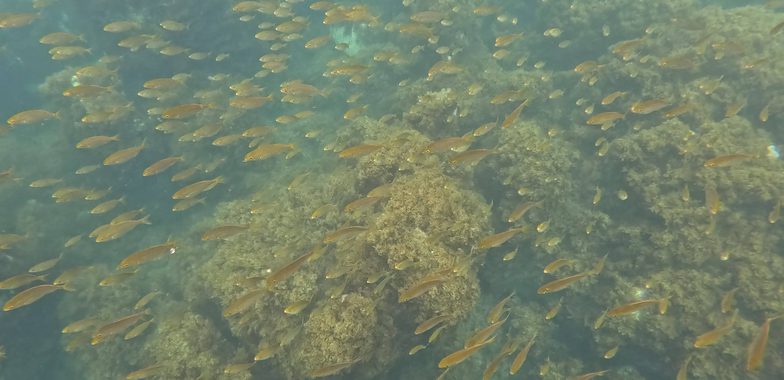

5. Volcanoes walk, Faial
Let's take the ferry across to Faial for the penultimate walk.
Faial is a smaller island than Pico, no more than 20 minutes across the water by ferry. What I love about it is that it has great swathes of laurisilva forest in the higher parts of the island. This is a sort of cloud forest which used to cover large parts of southern Europe, but which is now restricted to a few places such as the Azores, Madeira and the Canary Islands.
Up here, it's very cool, humid, damp... and very, very green. Pockets of clouds roll in and out quite quickly. It's therefore quite a dynamic environment and the views change a lot, yet the atmosphere is always hushed.



Inside this area of forest is the Caldeira - a huge crater which formed when an enormous volcano collapsed thousands of years ago. Unlike the Sete Cidades crater from walk 1 on São Miguel, this one doesn't contain water. It didn't fill up with water in the way you'd expect it to. Instead, it has shallow seasonal pools right down at the bottom.
What that means is that you have this HUUUUGE scoop of a crater that is filled with the greatest collection of endemic plants in the Azores.
You can go down into the crater with a licenced guide. But like climbing Pico volcano, it's a specialist and really quite demanding hike.
What works better for most, especially on clearer mornings, is to hike half the way around the rim of the crater and then follow a narrow levada water channel to connect with another of the official hiking routes. So in effect, we are blending three different official hikes here.
The hiking trail you are joining up with here is called the Dez Vulcões. The ten volcanoes. That gives you a real sense of the landscapes up here - lots of volcanic craters covered in forest.
The full offical walk is long and quite unforgiving to be honest, so we came up with a way that connects the crater with three of the volcanic cones. That you get a real sense of the forest and the volcanic topography.
It comes out at about 10km - nothing too strenuous, though you do want good visibility. Generally, to make it easier for you, we will have our driver drop you off at the start of the route, and then pick you up at the end at an agreed time. You then simply head back to your B&B and chill for the afternoon, putting your feet up with a drink back down at sea level.
6. Highlands to coast walk, São Jorge
And finally... São Jorge is the long, skinny island which faces Pico, about 45 minutes away by ferry.
It's shaped like a Toblerone, so hikes generally begin up in the highlands and wind their way down to the sea. That's what the PR1 hike does, which on a clear day is a strong contender for the best walk in the Azores in my book.
It's a linear route, just under 10km. You start up in the highlands, hopefully with a bit of a view back across the water to Pico. You then head down through beautiful laurisilva forest, passing Azorean heather trees and juniper bushes and then you start to see the other side of the island, which looks out to Terceira and Graciosa. So in less than than an hour or so, you've seen three different islands, whilst walking on a fourth.
The idea is to descend to two fajãs.
A fajã is a lava platform that has been formed by erosion or a landslide, and basically makes this little plateau which juts out into the sea below steep cliffs.
In the first fajã, there's an entire lagoon in the middle of the thing. And in both, you have these old seasonal houses where local farmers used to bring their herds down to the protection of the fajãs in the winter months, keeping them out of the rain and wind that hits the highlands in the winter. Some are still occupied, and you get this amazing feeling of complete isolation, almost cut off from the rest of the world.


Almost... but not quite. You do actually get a phone signal down here, so all you do is ping a message to our local driver when you reach a certain point, and they'll be waiting for you at the end of the trail when you get there. Even better, in summer, there are a couple of places you can eat down at sea level. So you can break your walk with a coffee or a light lunch and really soak in the views and the tranquillity.
Then, after being reunited with your car up at the top, if it's clear, it's nice to drive down to the end of the island to enjoy the views, have a little wander and maybe another drink, and then work your way back to your cabin for an hour or so on the terrace before dinner. Another brilliant, and brilliantly simple, day in the Azores.
So, we did it. Six hikes, four islands, up, down, along the coast and around volcanic craters.
Please do go and have a look around our island-hopping trips. The idea is that you can do all of these walks, plus whale watching, bathing in thermal pools, drinking Pico wine and eating in some fantastic restaurants, all on one two-week or so trip to the Azores.
As part of our holiday service to you, we give you easy access to GPS tracks for all the walks if you need them. There are red and yellow markers along all the routes, which makes it quite hard to get lost. But the tracks can be a helpful backup and we always explain which walks work best in our opinion.
The idea is that we make everything nice and simple for you so you don't have to think too much about the logistics. The trips can be tailored, so we can add more walking in here or there, and tweak things a little as needed.
But, honestly I love the Azores and I'd love you to come and experience them for yourselves. So... get in touch, let's talk and let's get you out there in your boots and enjoying these incredible trails.
